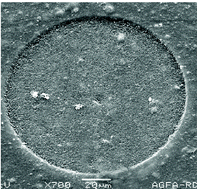A 193 nm ArF excimer-based laser ablation system coupled to an inductively coupled plasma mass spectrometer equipped with a dynamic reaction cell (LA-ICP-DRC-MS) was successfully used for the depth profiling analysis of several (multi-layered) industrial materials characterised by markedly different ablation behaviours and sample composition. To obtain the optimum depth resolution for each of the samples, crater geometry and parameters such as laser pulse energy were studied as a function of the sample composition and layer thickness. Layers with a thickness of <1 μm up to >200 μm could be studied. Combining LA-ICP-MS data with results obtained by scanning electron microscopy (SEM) and profilometry allowed useful information about the crater geometry and the ablation depth per pulse to be obtained. In this way, it was possible to convert the original intensity-versus-time into intensity-versus-depth profiles and to evaluate the figures of merit of LA-ICP-MS for depth profiling studies. To illustrate the possibilities of the technique under investigation, depth profiling analysis of a thermographic material, a CsBr phosphor screen and thermal printing plates was carried out. In all cases, the spatial resolution of the laser ablation system was sufficient to differentiate between the separate layers (even for very thin layers of ±1 μm), which makes the technique suitable for studying trace element distributions and diffusion effects in several high-tech materials. Spectral interferences hampering the accurate determination of S and K in the printing plate were overcome by using chemical resolution in the DRC. The use of O2 as a reaction gas permitted the simultaneous determination of all elements of interest (S as SO+, K as K+ and Zr as ZrO+).

You have access to this article
 Please wait while we load your content...
Something went wrong. Try again?
Please wait while we load your content...
Something went wrong. Try again?


 Please wait while we load your content...
Please wait while we load your content...